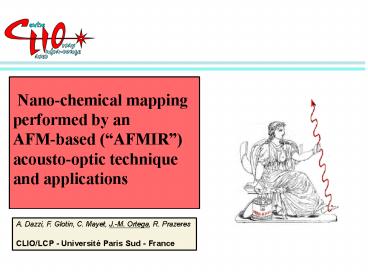Prsentation PowerPoint PowerPoint PPT Presentation
1 / 32
Title: Prsentation PowerPoint
1
Nano-chemical mapping performed by an AFM-based
(AFMIR) acousto-optic technique and
applications
- A. Dazzi, F. Glotin, C. Mayet, J.-M. Ortega, R.
Prazeres - CLIO/LCP - Université Paris Sud - France
2
Why infrared ?
- Many species have a characteristic absorption
spectrum - (chemical signature)
- Molecules (vibrations)
- Pseudo-atoms and molecules (defects in solids,
nanostructures) - Elementary excitations in solids (plasmons,
Cooper pairs...)
Linear spectroscopy Performed with blackbody
sources and synchrotron radiation
Non-Linear spectroscopy Performed with lasers,
particularly pulsed lasers
Microspectroscopy Resolution gt l/2 performed
with blackbody sources and synchrotron
radiation Resolution ltlt l/2 performed with
lasers ? tunable IR FEL
3
Infrared microspectroscopy
The infrared microspectroscopy associates lateral
resolution (microscopy) and IR spectral
analysis (chemical identification)
Classical sources provide lateral resolution gt l/2
Laser sources near-field techniques should
provide resolution ltlt l (illumination of small
objects requires beam of sufficient brightness)
- Near-field techniques
- Fully optical methods (SNOM, PSTM,
apertureless...) - New photo-acoustic method (AFMIR) to overcome
- the problems encountered with usual means
4
Example of a near-field method the PSTM (photon
scanning microscope)
Optical fiber
The electric field above the sample is sampled by
the tip (lt l) of an infrared transmitting
optical fiber (1st method used at CLIO in1995)
5
Disadvantages of all-optical near-field
High spatial resolution (ltlt l) requires a very
small thickness of the sample (ltlt l) --gt
Therefore the optical contrast becomes very small
(lt 1 ) (necessarily pulsed) tunable lasers do
not allow observation of such low contrasts
Moreover, there is no general method to separate
the contributions from
- The real part of n index of refraction
(topography, inhomogeneities)
- The imaginary part of n optical absorption
desired quantity
Differential methods are needed photoacoustics
6
The photothermal effect
7
Detection of dilatation
Diode laser
4 quadrant detector
AFM cantilever
dilatation
8
Experimental setup
9
A new method AFMIR
- A commercial AFM is used
- The sample is irradiated in PSTM configuration
- An IR absorption results in a local dilatation
- This dilatation is recorded by optical detection
of the tip motion - The transient character of the dilatation (due to
the pulsed nature of the laser) gt spatial
resolution - The topography is recorded at the same time
10
Test experiment
Bacteria Escherichia coli
Typical size 2-6 µm long 1-2 µm large and 500
nm height
FT-IR spectrum
AFM microscopy
11
Temporal response
s1650cm-1 (amide I)
E.coli
12
Temporal response
s1800cm-1 (out of bands)
E.coli
13
Temporal response
s1650cm-1 (amide I)
E.coli
Time (µs)
14
Fourier analysis
s1650cm-1
Resonances on E.coli
Resonances on ZnSe
15
Localised spectroscopy
FT-IR
AFMIR
FFT amplitude (nm)
Absorbance
16
Chemical mapping
s1800 cm-1
AFM topography
17
Chemical mapping
s1650 cm-1
AFM topography
18
Example of light distribution in tree different
bacteria a) height100 nm width 1.5µm b)
height210 nm width 1.5µm c) height450 nm
width 2µm
19
Mapping of amide I on a thin spectrally
homogeneous sample(nearly homogeneous lighting)
Topography
AFMIR
20
Virus T5 infecting E. Coli bacteria
- Most of its weight is constituted by DNA
- It has a protein envelope capsid
- The virus injects its DNA in the bacterium
through its tail - The DNA is replicated inside the infected cell
- New capsids are synthesized
- The process can be stopped at any stage
- Cells were dried in this experiment
21
Observation of an isolated virus T5 (Amide I
band at 1650 cm-1 capsid)
AFM
AFMIR
22
Observation of isolated virus T5 (DNA band at
1050 cm-1 the dried virus has expelled its DNA
and looks diluted)
AFM
AFMIR
23
Observation of an heavily infected bacterium
Topography (AFM)
AFMIR (bande de lADN)
24
Observation of a single virus infecting a
bacterium
AFMIR (ADN bande)
Topographie (AFM)
25
Zooming on the single virus
26
First experiments living cells (in water)(on
candida albicans cells)
Frequency response of the cantilever
On the cell in air
In water on the cell (red) on
substrate (blue)
gt selecting the peak frequency (31,6 MHz)
allows to image the cell
27
AFM topography
Mapping in water of living cells (candida
albicans glued on the substrate) Wavelength
1080 cm-1
AFMIR Topography at 80 kHz
AFMIR Topography at 31.6 kHz
28
Why is the observed spatial resolution so good ?
- AFMIR spatial resolution is lt 100 nm
- limited by tip size, sample characteristics, S/N
ratio - One expect heat diffusion of _at_1 µm/µs (speed of
sound) - Measurement is done in more than tens of µs
- gt surprising that resolution ltlt 1 µm
- Simulations show that the heat is diluted in
- the substrate and in air
- gt Almost no signal outside the absorbing zone
29
COMSOL simulation of cooling of an hemispherical
object
gt After excitation of the cantilever
vibration, the heat is diluted extremely rapidly
in the substrate
(but too many excited samples on the substrate
can pollute the signal)
30
COMSOL simulation of transient dilatation around
the virus
The spatial resolution is limited at _at_ 200 nm in
the case of the buried virus
31
Application absorption nanospectroscopy of a
single quantum dot
800 nm
InAs/GaAs self-assembled quantum dot Quantum
dots are buried and cannot be observed by AFM
Density 400 dots per µm2 20 nm diameter n-type
doping Resonant absorption in the mid-infrared
Single quantum dot absorption _at_ room temperature
lexc 9.6 µm Measurement performed with CLIO
AFMIR
Spatial resolution 80 nm
J. Houel, S. Sauvage, P. Boucaud
32
ConclusionAFMIR CLIO/OPO capabilities
- Powerful tool to measure local relative
absorption - Good spectral resolution (fit well FT-IR
spectrum) - High spatial resolution (lt 100 nm ltlt linfrared)
- Various applications underway

